
Flower Mold, Red, 2010
Pigment print on rag paper, printed by Studio Franck Bordas
© Elizabeth Lennard
Courtesy Galerie Pixi Marie-Victoire Poliakoff / Les Douches la Galerie, Paris
Dans ma cuisine
Patrick Bailly-Maître-Grand » Aurel Bauh » Valérie Belin » Anna & Bernhard Blume » Erwin Blumenfeld » Thomas Boivin » Roger Catherineau » Yvonne Chevalier » Stéphane Couturier » Denis Darzacq » Emeric Feher » Alain Fleischer » Henri Foucault » Raymond Journeaux » Michel Journiac » André Kertész » François Kollar » Elisabeth Lennard » Daniel Masclet » André Papillon » Gaston Paris » Irving Penn » Bernard Plossu » René-Jacques » August Sander » André Steiner » Maurice Tabard » Claude Tolmer » Patrick Tosani » Raoul Ubac » Romain Urhausen » Sabine Weiss » Willy Otto Zielke »
Exhibition: 11 Apr – 31 Jul 2025
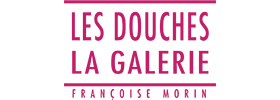
Les Douches La Galerie
54 Rue Chapon
75003 Paris
+33 1-78 94 03 00
contact@lesdoucheslagalerie.com
www.lesdoucheslagalerie.com
Wed-Sat 14-20+
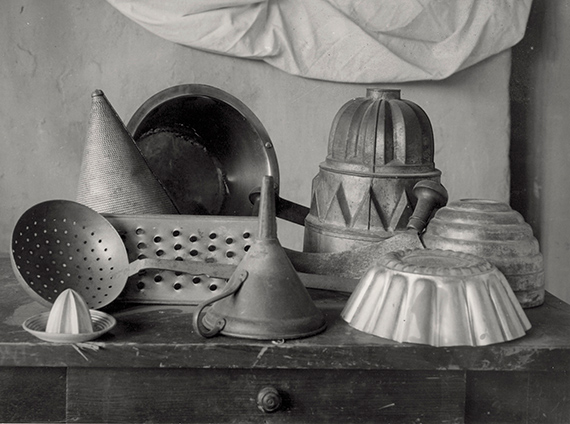
Genève, 1946
Gelatin silver print, printed later
© Estate Sabine Weiss
A tight framing on two hanging keys, a container, a sponge, four objects suspended on a white wall, and a few ceramic tiles... This 1939 photograph by Daniel Masclet is intriguing. It deliberately embraces its own banality, both through its subject matter and the title given by its author: Dans ma cuisine. There is nothing exotic, no promise of elsewhere, no event or decisive moment to capture. Daniel Masclet draws our attention to a seemingly insignificant corner of his apartment, inviting us to look differently, to linger on this arrangement of everyday objects that possess no apparent aesthetic value. This photograph serves as the starting point for our exhibition, bearing the same title, to explore how and why kitchens and culinary arts, along with their contents, have become subjects of interest for photographers over the decades.
La table servie1 (circa 1823-30), one of the earliest photographs in the history of the medium, attributed to Nicéphore Niépce (perhaps in collaboration with Louis Daguerre), features bottles, a glass, a spoon, a knife, and a piece of bread, all arranged on a white tablecloth draped over a table. In his pursuit of a new photographic process, Niépce adopted the visual codes of still life painting. This early attempt at recording reality was later pursued by photographers in the second half of the 19th century (Charles Aubry, Adolphe Braun, Charles Carey, etc.), who honed their craft on inanimate, docile subjects, favoring bouquets of flowers, still lifes with skulls, rabbits, and hanging pheasants, or other accumulations of antiques and sculptures, thus adhering to the conventions of fine art.
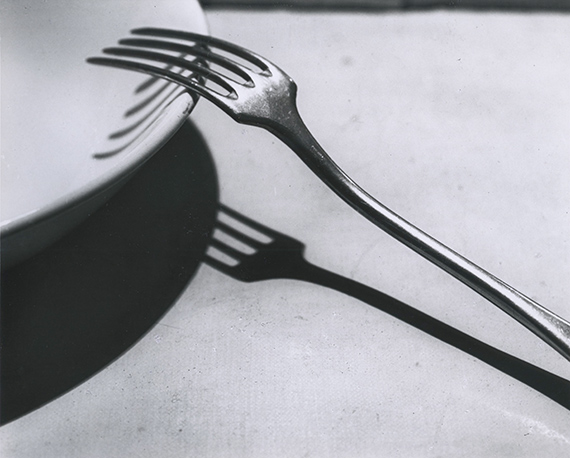
La fourchette, Paris, 1928
Gelatin silver print, printed later
© Estate André Kertész
Courtesy Les Douches la Galerie, Paris
Two iconic images from 1930s photography immediately come to mind when we think of kitchens and photography: André Kertész’s Fork (1928) and Edward Weston’s Pepper (1930). These two images mark both the inheritance of and a turning point in the art of still life photography. As Sylvie Aubenas and Dominique Versavel highlight in their book Objet dans l’objectif2, the 20th century, with Marcel Duchamp’s inverted urinal or his bottle rack, “heralds the transformations of the new century: the rejection of conventional artistic subjects, multiple interpretations of objects, the growing prominence of objects in the visual landscape of the interwar period, and the renewal of artistic language through photography, among other media.”
Manufactured objects related to the kitchen—cups, glasses, carafes, plates, kitchen utensils, molds—were mass-produced, permeating everyday life and establishing themselves as modern subjects for photographers. For a variety of reasons like advertising commissions, personal artistic endeavors, research or illustration, photographers transformed the kitch-en into a laboratory of experimentation. The kitchen of Eileen Gray’s Villa E 127, revisited by Stéphane Couturier, became a subject of study; everyday items turned into a resource of forms, materials, and textures; and the kitchen itself emerged as a realm where every utensil and every ingredient stimulated the photographer’s visual and creative appetite, challenging their imagination—seen in Henri Foucault’s pasta photograms or Denis Darzacq’s pear-banana compositions. The kitchen is a cavern of endless possibilities, a treasure trove of subjects: the transparency of glasses and its optical challenges (Willy Zielke, Valérie Belin), the mysterious shadows of colanders (Patrick Bally-Maître-Grand), the enigmatic reflections of cutlery (Maurice Tabard, Alain Fleischer, Patrick Tosani), the geometric patterns of dishware (François Kollar, Gaston Paris), the poetic forms of molds (Elizabeth Lennard, Sabine Weiss). All these objects reveal new dimensions through analog photography.
In the 1950s, Daniel Masclet, who was both a photography critic and theorist, seemed to pay homage to the history of the medium with his set table, a still life reminiscent of that captured by the inventor of photography himself. Meanwhile, Roger Catherineau transformed sprouting potatoes into monstrous insects, and Raymond Journeaux created geometric compositions using eggs.
- Eric Rémy, Curator
1 Probably made using the physautotype process but the original has disappeared.
2 Objet dans l’objectif de Nadar à Doisneau, Sylvie Aubenas and Dominique Versavel, BNF, 2005, p. 16.
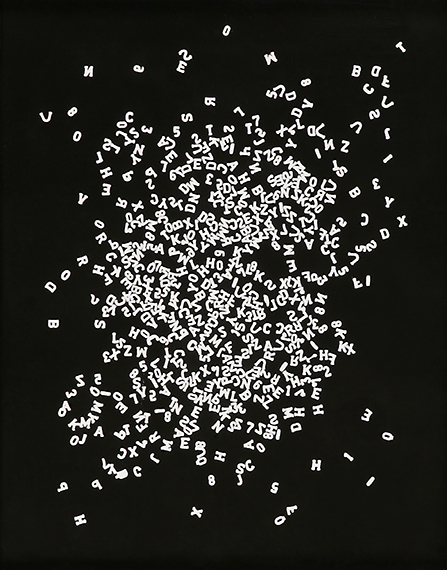
Presque rien, 1992
Vintage photogram, printed by the artist Unique print
© Henri Foucault, ADAGP, Paris Courtesy Les Douches la Galerie, Paris
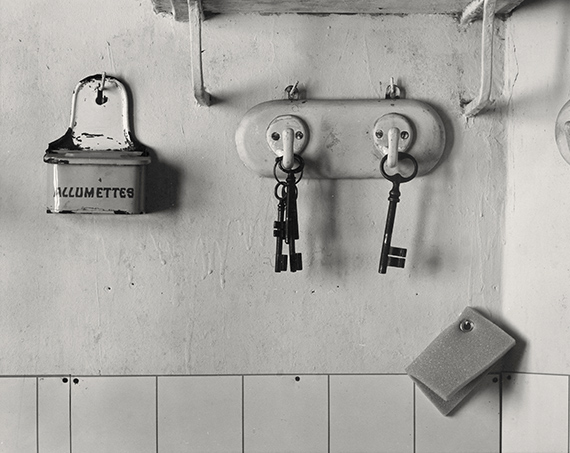
Dans ma cuisine, 1939
Vintage gelatin silver print
© Estate Daniel Masclet
Courtesy Les Douches la Galerie, Paris
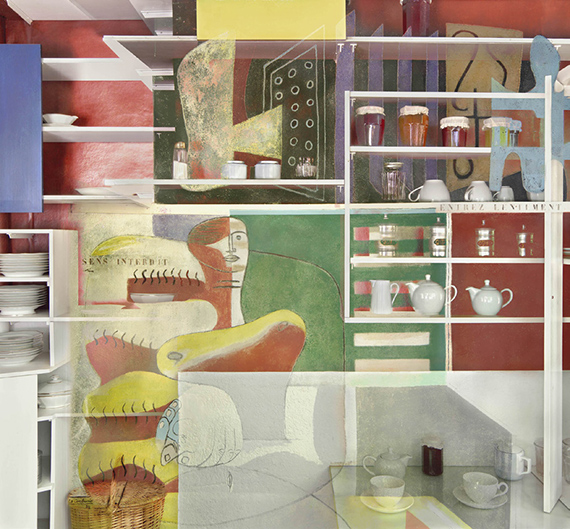
Série E1027-123 - Villa E. Gray, Photo n°31, 2021-2023
C-print
© Stéphane Couturier / Fondation Le Corbusier, ADAGP
Courtesy Galerie Christophe Gaillard / Les Douches la Galerie, Paris

Passoire à photons, 2014
Gelatin silver print, printed by the artist
© Patrick Bailly-Maître-Grand
Courtesy Galerie Baudoin Lebon / Les Douches la Galerie, Paris